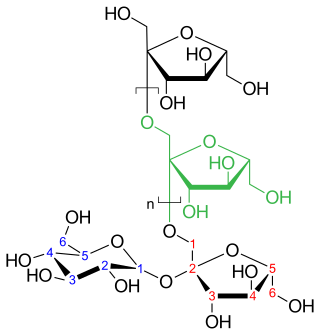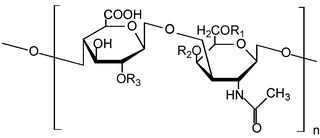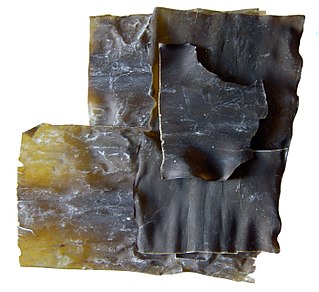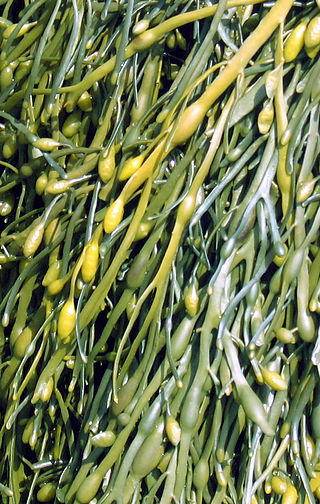Related Research Articles

Polysaccharides, or polycarbohydrates, are the most abundant carbohydrates found in food. They are long-chain polymeric carbohydrates composed of monosaccharide units bound together by glycosidic linkages. This carbohydrate can react with water (hydrolysis) using amylase enzymes as catalyst, which produces constituent sugars. They range in structure from linear to highly branched. Examples include storage polysaccharides such as starch, glycogen and galactogen and structural polysaccharides such as cellulose and chitin.

Carrageenans or carrageenins are a family of natural linear sulfated polysaccharides that are extracted from red edible seaweeds. Carrageenans are widely used in the food industry, for their gelling, thickening, and stabilizing properties. Their main application is in dairy and meat products, due to their strong binding to food proteins. In recent years, carrageenans have emerged as a promising candidate in tissue engineering and regenerative medicine applications as they resemble native glycosaminoglycans (GAGs). They have been mainly used for tissue engineering, wound coverage, and drug delivery.

Inulins are a group of naturally occurring polysaccharides produced by many types of plants, industrially most often extracted from chicory. The inulins belong to a class of dietary fibers known as fructans. Inulin is used by some plants as a means of storing energy and is typically found in roots or rhizomes. Most plants that synthesize and store inulin do not store other forms of carbohydrate such as starch. In the United States in 2018, the Food and Drug Administration approved inulin as a dietary fiber ingredient used to improve the nutritional value of manufactured food products. Using inulin to measure kidney function is the "gold standard" for comparison with other means of estimating glomerular filtration rate.

Chondroitin sulfate is a sulfated glycosaminoglycan (GAG) composed of a chain of alternating sugars. It is usually found attached to proteins as part of a proteoglycan. A chondroitin chain can have over 100 individual sugars, each of which can be sulfated in variable positions and quantities. Chondroitin sulfate is an important structural component of cartilage, and provides much of its resistance to compression. Along with glucosamine, chondroitin sulfate has become a widely used dietary supplement for treatment of osteoarthritis, although large clinical trials failed to demonstrate any symptomatic benefit of chondroitin.
Fucoxanthin is a xanthophyll, with formula C42H58O6. It is found as an accessory pigment in the chloroplasts of brown algae and most other heterokonts, giving them a brown or olive-green color. Fucoxanthin absorbs light primarily in the blue-green to yellow-green part of the visible spectrum, peaking at around 510-525 nm by various estimates and absorbing significantly in the range of 450 to 540 nm.

Konbu is edible kelp mostly from the family Laminariaceae and is widely eaten in East Asia. It may also be referred to as dasima or haidai.

Ascophyllum nodosum is a large, common cold water seaweed or brown alga (Phaeophyceae) in the family Fucaceae. A. nodosum is also known in localities as feamainn bhuí, rockweed, Norwegian kelp, knotted kelp, knotted wrack or egg wrack. It is a seaweed that dominates the intertidal zone and grows only in the northern Atlantic Ocean, along the north-western coast of Europe including east Greenland and the north-eastern coast of North America, its range further south of these latitudes being limited by warmer ocean waters. Ascophyllum nodosum has been used numerous times in scientific research and has even been found to benefit humans through consumption.

Fucose is a hexose deoxy sugar with the chemical formula C6H12O5. It is found on N-linked glycans on the mammalian, insect and plant cell surface. Fucose is the fundamental sub-unit of the seaweed polysaccharide fucoidan. The α(1→3) linked core of fucoidan is a suspected carbohydrate antigen for IgE-mediated allergy.
Heparinoids are glycosaminoglycans which are chemically and pharmacologically related to heparin. They include oligosaccharides and sulfated polysaccharides of plant, animal, or synthetic origin. Multiple scientific studies have been conducted on heparinoids.
Sulfation is the chemical reaction that entails the addition of SO3 group. In principle, many sulfations would involve reactions of sulfur trioxide (SO3). In practice, most sulfations are effected less directly. Regardless of the mechanism, the installation of a sulfate-like group on a substrate leads to substantial changes.

Mastocarpus stellatus, commonly known as carrageenan moss or false Irish moss, is a species in the Rhodophyceae division, a red algae seaweed division, and the Phyllophoracea family. M. stellatus is closely related to Irish Moss. It grows in the intertidal zone. It is most collected in North Atlantic regions such as Ireland and Scotland, together with Irish moss, dried, and sold for cooking and as the basis for a drink reputed to ward off colds and flu. Marine biologists have completed studies on the medicinal reputation of M. stellatus to discover the full potential of its pharmaceutical benefits. Additionally, marine biologists have conducted research on its potential to serve as an alternative to plastic. The application of M. stellatus in these different industries is correlated with the seaweed's adaptations which developed in response to the environmental stressors present around its location on the rocky intertidal.

Udotea is a genus of green algae in the family Udoteaceae.

Turbinaria is a genus of brown algae (Phaeophyceae) found primarily in tropical marine waters. It generally grows on rocky substrates. In tropical Turbinaria species that are often preferentially consumed by herbivorous fishes and echinoids, there is a relatively low level of phenolics and tannins.

Seaweed, or macroalgae, refers to thousands of species of macroscopic, multicellular, marine algae. The term includes some types of Rhodophyta (red), Phaeophyta (brown) and Chlorophyta (green) macroalgae. Seaweed species such as kelps provide essential nursery habitat for fisheries and other marine species and thus protect food sources; other species, such as planktonic algae, play a vital role in capturing carbon, producing at least 50% of Earth's oxygen.

Saccharina latissima is a brown alga, of the family Laminariaceae. It is known by the common names sugar kelp, sea belt, and Devil's apron, and is one of the species known to Japanese cuisine as kombu. It is found in the north Atlantic Ocean, Arctic Ocean and north Pacific Ocean. It is common along the coast of Northern Europe as far south as Galicia Spain, the coast of North America north of Massachusetts and central California, and the coast of Asia south to Korea and Japan.

Edible seaweed, or sea vegetables, are seaweeds that can be eaten and used for culinary purposes. They typically contain high amounts of fiber. They may belong to one of several groups of multicellular algae: the red algae, green algae, and brown algae. Seaweeds are also harvested or cultivated for the extraction of polysaccharides such as alginate, agar and carrageenan, gelatinous substances collectively known as hydrocolloids or phycocolloids. Hydrocolloids have attained commercial significance, especially in food production as food additives. The food industry exploits the gelling, water-retention, emulsifying and other physical properties of these hydrocolloids.
Beta porphyranase is an enzyme responsible for the degradation of porphyran, which composes the cell wall of red algae. So far only five β-porphyranases have been identified: PorA and PorB are found in the marine bacteria Zobellia galactinovirans. A wild-type porphyranase activity has been found in Pseudoalteromonas atlantica. BpGH16B and BpGH86A have been found in the human gut bacterium, Bacteroides plebeius, of Japanese individuals.
Medicinal fungi are fungi that contain metabolites or can be induced to produce metabolites through biotechnology to develop prescription drugs. Compounds successfully developed into drugs or under research include antibiotics, anti-cancer drugs, cholesterol and ergosterol synthesis inhibitors, psychotropic drugs, immunosuppressants and fungicides.

Ulva australis, the southern sea lettuce, is a species of bright green coloured seaweed in the family Ulvaceae that can be found in waters around Australia and was first described by Swedish botanist Johan Erhard Areschoug. It is an edible green algae, although sometimes designated as a seaweed. General characteristics of Ulva australis include a smooth surface, distromatic blades, lobed fronds, and thallus color from dark green to light grass green. It can be either free floating or attached by a single holdfast. Its cells appear to be irregularly arranged, have rounded edges, and have shapes such as rectilinear, square, and pentagonal.
Seaweed fertiliser is organic fertilizer made from seaweed that is used in agriculture to increase soil fertility and plant growth. The use of seaweed fertilizer dates back to antiquity and has a broad array of benefits for soils. Seaweed fertilizer can be applied in a number of different forms, including refined liquid extracts and dried, pulverized organic material. Through its composition of various bioactive molecules, seaweed functions as a strong soil conditioner, bio-remediator, and biological pest control, with each seaweed phylum offering various benefits to soil and crop health. These benefits can include increased tolerance to abiotic stressors, improved soil texture and water retention, and reduced occurrence of diseases.
References
- 1 2 3 Fitton, J Helen (2011). "Therapies from Fucoidan; Multifunctional Marine Polymers". Marine Drugs. 9 (10): 1731–1760. doi: 10.3390/md9101731 . PMC 3210604 . PMID 22072995.
- 1 2 Berteau & Mulloy (2003) [18] apud Otari & Jadhave (2021), p. 129 [19]
- ↑ Atashrazm, Farzaneh (2015). "Fucoidan and Cancer: A Multifunctional Molecule with Anti-Tumor Potential". Marine Drugs. 13 (4): 2327–2346. doi: 10.3390/md13042327 . PMC 4413214 . PMID 25874926.
- 1 2 Fitton, J Helen (2015). "Therapies from Fucoidan: An Update". Marine Drugs. 13 (9): 5920–5946. doi: 10.3390/md13095920 . PMC 4584361 . PMID 26389927.
- ↑ Ale, Marcel (2011). "Important determinants for fucoidan bioactivity: a critical review of structure-function relations and extraction methods for fucose-containing sulfated polysaccharides from brown seaweeds". Marine Drugs. 9 (10): 2106–2130. doi: 10.3390/md9102106 . PMC 3210621 . PMID 22073012.
- ↑ Dillehay, Tom (2008). "Seaweed, Food, Medicine, and the Peopling of South America". Science. 320 (5877): 784–786. doi:10.1126/science.1156533. PMID 18467586. S2CID 25648338.
- ↑ Kylin, Harald (1913). "Zur biochemie der meeresalgen". Hoppe-Seyler's Z. Physiol. 83 (3): 171–197. doi:10.1515/bchm2.1913.83.3.171.
- ↑ McNeely, W (1959). "Industrial gums". Academic Press: 117–125.
- ↑ Black, W (1951). "Manufacture of algal chemicals. IV†—Laboratory‐scale isolation of fucoidin from brown marine algae". J. Appl. Chem. 1 (3): 122–129. doi:10.1002/jsfa.2740030305.
- ↑ Yamamoto, I (1974). "Antitumor effect of seaweeds. I. Antitumor effect of extracts from Sargassum and Laminaria". Jpn J Exp Med. 66 (6): 543–6. PMID 4455962.
- ↑ Sugawara, I (1982). "Polysaccharides with sulfate groups are human T-cell mitogens and murine polyclonal B-cell activators (PBAs). I. Fucoidan and heparin". Cell Immunol. 74 (1): 162–71. doi:10.1016/0008-8749(82)90016-8. PMID 6760994.
- ↑ Teas, J (1984). "Dietary seaweed (Laminaria) and mammary carcinogenesis in rats". Cancer Research. 44 (7): 2758–61. PMID 6426785.
- ↑ Nakashima, H (1987). "Sulfation of polysaccharides generates potent and selective inhibitors of human immunodeficiency virus infection and replication in vitro". Jpn J Cancer Res. 78 (11): 1164–8. PMID 2447045.
- ↑ Chong, AS (1986). "Cell surface receptors for sulphated polysaccharides: a potential marker for macrophage subsets". Immunology. 58 (2): 277–84. PMC 1452651 . PMID 3011656.
- 1 2 3 Fitton, J Helen (2019). "Therapies from Fucoidan: New Developments". Marine Drugs. 17 (10): 571. doi: 10.3390/md17100571 . PMC 6836154 . PMID 31601041.
- ↑ Luthuli, S (2019). "Therapeutic Effects of Fucoidan: A Review on Recent Studies". Marine Drugs. 17 (9): 487. doi: 10.3390/md17090487 . PMC 6780838 . PMID 31438588.
- ↑ Yao, Yuan; Yim, Evelyn K. F. (2021-10-15). "Fucoidan for cardiovascular application and the factors mediating its activities". Carbohydrate Polymers. 270: 118347. doi:10.1016/j.carbpol.2021.118347. ISSN 0144-8617. PMC 10429693 . PMID 34364596.
- ↑ Berteau, Olivier [in French]; Mulloy, Barbara (2003). "Sulfated fucans, fresh perspectives: structures, functions, and biological properties of sulfated fucans and an overview of enzymes active toward this class of polysaccharide". Glycobiology. 13 (6): 29R–40R. doi:10.1093/glycob/cwg058.
- ↑ Otari, Sachin V.; Jadhave, Jyoti P. (2021). "Chapter 6. Seaweed-Based Biodegradable Biopolymers, Composite, and Blends with Applications". In Pant, Deepak; Bhatia, Shashi Kant; Patel, Anil K.; Giri, Anand (eds.). Bioremediation using weeds: Energy, Environment, and Sustainability. Springer Nature. p. 34. ISBN 9789813365520.
- ↑ Pereira, Leonel (2020). "8 Colloid Producing Seaweeds: Agrophytes, Carrageenophytes and Alginophytes Biodiversity". In Kim, Se-Kwon (ed.). Encyclopedia of Marine Biotechnology. John Wiley & Sons. p. 280. ISBN 9781119143796.
- ↑ Katayama, Shigeru; Nishio, Toshihiro; Iseya, Zensuke; Saeki, Hiroki (April 2009). "Effects of manufacturing factors on the viscosity of a polysaccharide solution extracted from Gagome kjelllmaniella crassifolia". Fisheries Science. 75: 491–497. doi:10.1007/s12562-009-0070-8.
- ↑ Encyclopedia of Marine Biotechnology (2020) s.v. Saccharina sculpera syn. Kjellmaniella crassifolia, [20] citing Katayama et al. (2009). [21]
- 1 2 Yamada (2006), p. 50.
- ↑ Yamada (2006), pp. 46–47.
- ↑ Citkowska, Aleksandra; Szekalska, Marta; Winnicka, Katarzyna (5 August 2019). "Possibilities of Fucoidan Utilization in the Development of Pharmaceutical Dosage Forms". Marine Drugs. 17 (8): 458. doi: 10.3390/md17080458 . PMC 6722496 . PMID 31387230.
{{cite journal}}: CS1 maint: multiple names: authors list (link) - ↑ Monagail, M (2017). "Sustainable harvesting of wild seaweed resources". European Journal of Phycology. 52 (4): 371–390. doi:10.1080/09670262.2017.1365273. S2CID 90699130.
- Bibliography
- Yamada, Nobuo (2006). Kaisō fukoidan no kagaku海藻フコイダンの科学. Seizando-shoten Publishing. ISBN 9784425882816.(in Japanese)